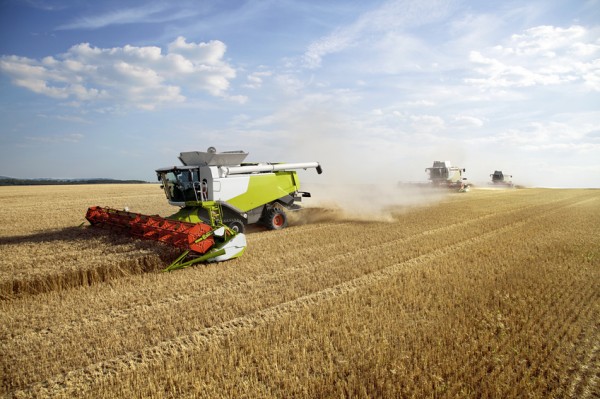The Crop Factor: Efficiency in Agriculture
08/09/2013
The agricultural market is a growth market: Demand for agricultural machinery and agrochemicals is due to increase significantly within the next few years. Most important drivers are a growing world population and growth of income, which has an impact on nutritional habits. Yet agricultural production remains inefficient in many parts of the world.
The ongoing growth of the world’s population and increasing income influence the demand for agricultural products with regard to type and amount. However, the rate of growth of the supply of agricultural products recently slackened. After 2.6% annual growth in the first decade of the millennium, OECD and FAO expect growth below the 2% mark until 2020.A major reason is that agricultural area can no longer be expanded at will. Newly cultivated areas are often subject to rather unfavorable conditions (e.g. drought or poor soil). Additionally, in many regions of the world crop yields are stagnating due to erosion or disease. Also extreme weather conditions such as the recent drought in the US Midwest or in Russia have lowered the harvest enormously. To meet the world population’s demand for agricultural products and to take account of changing nutritional habits agricultural production needs to become more efficient. This creates a need for new methods, machines, and auxiliary products.Improved machinery in combination with innovative soil treatment technologies (e.g. no-till methods) can contribute to better plant growth and less soil erosion.In 2012, the global agricultural machinery market reached a value slightly above EUR 75 bn. The production of agricultural machines is estimated to grow by over 6% p.a. during the upcoming years. Especially Brazil and China will boost demand with an above average growth rate. However, the market is driven not only by the demand for agricultural machinery, but also by the demand for innovations: Ten years ago, a farmer would fertilize plants evenly and on the basis of experience. Nowadays, the use of GPS-aided systems for tractors as well as image-analysis based application of fertilizers and plant protection have become available.Furthermore, there is a growing demand for products which can significantly lower water consumption or protect the plant from environmental stress (e.g. heat or UV radiation).This trend offers manufacturers of geotextiles or water storing substances promising new opportunities.Another important growth area is yield improvement by crop protection. 30 to 40% of the harvest is estimated to be lost due to insufficient crop protection. Traditional crop protection, i.e. use of insecticide, pesticide, and fungicide, focuses on control of insects, rodents, weeds, and fungi. Globally, the market for these products is valued at more than EUR 40 bn. p.a. with a growth rate of 4 to 5%. Beyond that, new approaches to plant protection are being developed, which focus on improving the vigor of the plant itself. Besides genetic methods, seed or foliar plant treatment can accomplish this. This type of plant protection offers even higher growth rates than conventional plant protection.In addition, the demand for improved fertilizing methods is growing constantly. Currently fertilizers with a value of almost EUR 150 bn are used worldwide every year. While the amount measured in tons of fertilizers is growing by 2% p.a., the growth of market value exceeds 4% p.a. Besides price changes for conventional fertilizers, the demand for high-value specialty fertilizers plays a crucial role. These include slow-release fertilizers, which show increased efficiency and simultaneously reduce the loss of unused fertilizer through biological processes. The global market for fertilizers is undergoing significant structural change: On the one hand, China has become by far the world’s largest user of fertilizers. On the other hand, new suppliers, especially from Russia, have entered the fertilizer market. Around 80% of Russian fertilizer production is destined for export. Due above all to its rich deposits, Russia has a market share of 10% of global fertilizer production. Russian producers are attempting to strengthen their market position through M&A activities: Last year the Russian company Eurochem acquired BASF’s fertilizer subsidiary.Besides energy-intensive production of conventional fertilizers, fertilizer efficiency is becoming an ever more important issue. This is not only for cost reasons but also because of environmental regulation, which is becoming increasingly strict also outside of Europe. A disproportionately high demand for fertilizer efficiency technology is expected in the near future.In summary, the agricultural market is a growth market increasingly in need of innovative solutions. However, the introduction of new innovative products is often difficult. The farmer often fails to recognize the benefit of the new product and additionally needs to adapt his system and habits. In the development of a new product it is therefore necessary not only to rely on experts’ opinions but also to seek discussions with farmers, during which the chances of a rapid market introduction can easily be assessed. Additionally, these discussions can provide a basis for deciding whether to create a market entry strategy or to discontinue product development.Schlegel and Partners is able to generate information globally along the value chain, including producers of primary products (i.e. chemical companies), specialized formulators, marketing companies, small and large distributors, as well as farmers. Accordingly, we are able to provide reliable estimates of market figures and determine the needs of players along the agricultural value chain.
Download: SuP Crop factor 2013_EN.pdf, 107976 kB